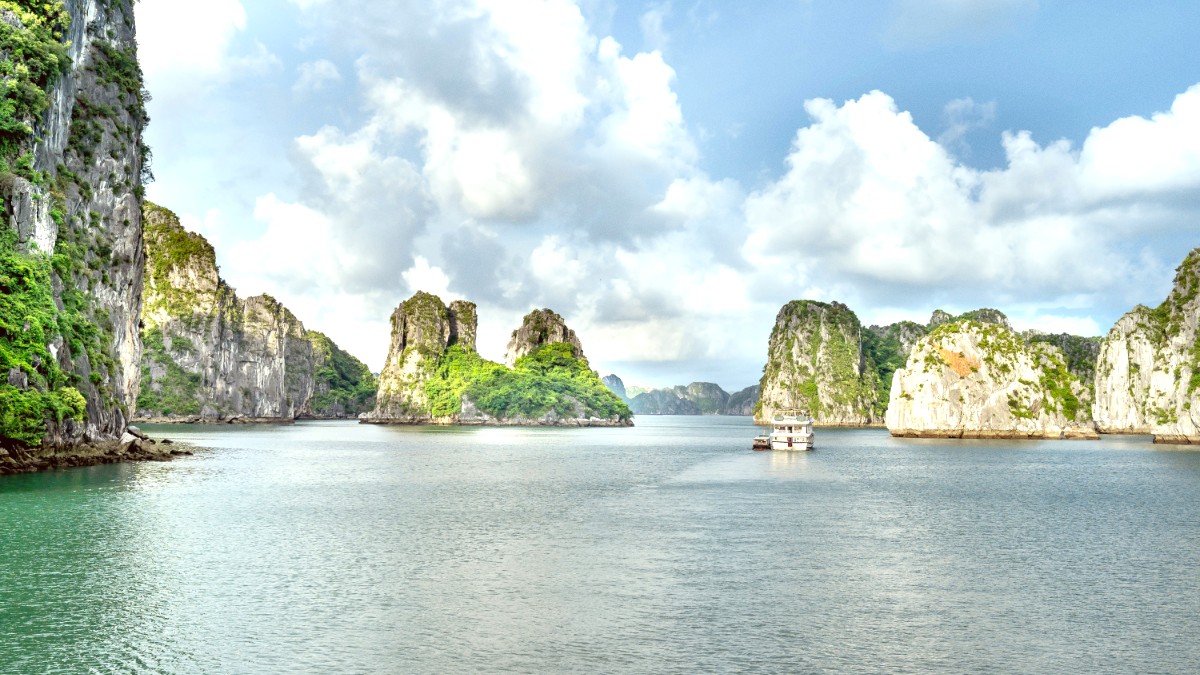
Northeast Vietnam, Vietnam
A journey into Halong Bay is more than a simple trip; it becomes an immersion into a living painting. Picture yourself gliding across the water on a traditional junk boat, the silence broken only by the gentle lapping of waves against limestone cliffs. You might paddle a kayak into a hidden grotto, discovering untouched pockets of serenity. Or perhaps climb to a viewpoint, where the sheer scale of the bay unfolds beneath you, a panorama of green islands scattered across endless blue. This destination holds UNESCO World Heritage status, a testament to its exceptional universal value and breathtaking aesthetic.
Generations of local people have called this bay home, fostering a deep connection with its waters and islands. Ancient legends tell tales of dragons descending from the heavens, creating the very karsts that dot the horizon. This mythology adds another layer of intrigue to the landscape. Visitors gain more than just stunning photographs; they gain an appreciation for a place where nature and human history intertwine.
The bay’s allure lies not just in its dramatic beauty, but in the sense of wonder it inspires. It prompts reflection on the power of geological forces and the quiet persistence of life lived in harmony with the environment. Prepare to have your expectations surpassed by the sheer magnificence of Halong Bay.
Halong Bay sits in the Gulf of Tonkin, within Quang Ninh Province, in the northeast region of Vietnam. It spans an area of approximately 1,553 square kilometers (599 square miles). This vast expanse includes over 1,600 limestone karsts and islands, though only about 40 of them are inhabited. Geologically, the bay is a remarkable example of karst topography. This formation results from millions of years of limestone erosion by water. The process creates towering pillars, intricate caves, and secluded grottoes. The entire landscape presents a vivid testament to geological evolution.
Halong Bay's history extends back many millennia, far beyond its modern recognition as a tourist destination. Archaeological evidence points to human habitation in the area as early as 18,000 to 7,000 BC, during the Soi Nhu culture period. Later, the Cai Beo culture (7,000 to 5,000 BC) and the Halong culture (5,000 to 3,500 BC) left behind tools, pottery, and shell middens. These findings show a deep, enduring connection between early human communities and the bay's rich marine resources. For these ancient people, the bay was not just a scenic backdrop; it was a source of sustenance and shelter. The countless caves provided natural protection, while the calm waters offered abundant fishing grounds.
Soi Nhu culture (18,000-7,000 BC) and later cultures.
General Tran Hung Dao used the bay against Mongol invaders (1288).
Brought international attention, named "Baie d'Along".
Recognized for aesthetic (1994) and geological (2000) values.
Centuries-old communities living directly on the water.
The bay’s unique geography divides into three main zones that share similar geological characteristics. These zones include Halong Bay proper, Lan Ha Bay to the south, and Bai Tu Long Bay to the east. While all three feature stunning limestone formations, they offer distinct experiences. Halong Bay itself sees the most tourist traffic and hosts the majority of cruises. Lan Ha Bay, often accessed from Cat Ba Island, provides a slightly less crowded alternative with pristine beaches and clearer waters. Bai Tu Long Bay, further east, maintains a more untouched, tranquil atmosphere, attracting fewer visitors and focusing on sustainable tourism. Each area presents a different perspective on the region’s natural splendor.
Geological surveys indicate that the limestone in Halong Bay formed over 300 million years ago. Subsequent tectonic activity and climate shifts led to the uplift and erosion that created the current dramatic landscape. The bay’s unique dissolutional karst geomorphology, a process where rainwater and groundwater dissolve soluble bedrock like limestone, defines its character. This process continues today, albeit at a slow pace.
Halong Bay’s marine environment supports a diverse ecosystem. The warm, shallow waters host a variety of fish, shellfish, and coral species. Mangrove forests line some of the coastal areas, serving as nurseries for marine life and protecting shorelines from erosion. While human activity and tourism have made their mark on the bay, conservation efforts attempt to preserve its delicate balance.
Halong Bay offers a compelling combination of breathtaking scenery, unique experiences, and cultural insights. Prepare for a destination mainly revolving around its water-based activities.
Most visitors experience the bay through cruises, which range from short day trips to luxurious multi-night excursions. These cruises include accommodation, meals, and guided tours to the bay’s attractions. The bay's defining feature is its thousands of limestone karsts and islets. These formations rise dramatically from the emerald waters, creating a surreal landscape.
Halong City serves as the gateway to the bay, providing hotels, restaurants, and entertainment. Cat Ba Island, the largest island, delivers a more active, outdoors-focused experience with hiking and rock climbing.
Spring (March-April) and Autumn (September-October) have pleasant weather and clear skies.
Vietnam uses VND. Options available for various budgets, from budget to luxury.
Generally safe for tourists; stay vigilant for petty theft. Drink bottled water.
Popular activities include kayaking through hidden grottoes, swimming at secluded beaches, and exploring magnificent caves. Many cruises also feature cooking demonstrations and squid fishing experiences. You find a different ambiance on Cat Ba Island with its national park and historic sites.
Consider a local SIM card for communication and navigation. English speakers are in tourist areas, but a Translation app can be useful locally. Embrace the local culture and prepare for an unforgettable journey.